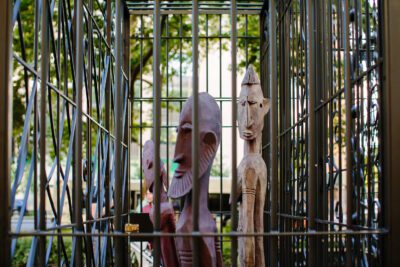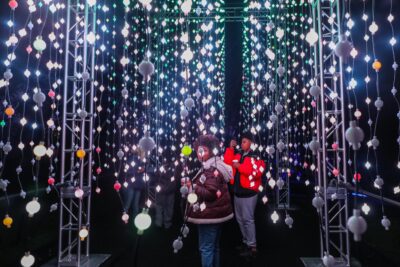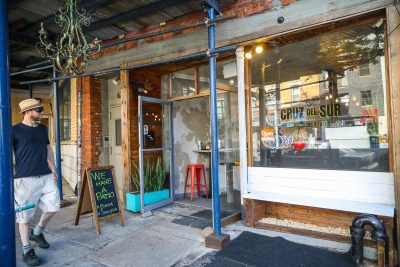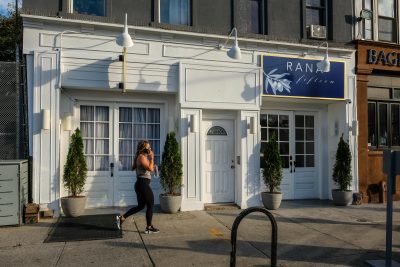'The Flowers of Hypnosis' at the Japanese Hill-and-Pond Garden at Brooklyn Botanic Garden. Photographer: Guillaume Ziccarelli. ©Jean-Michel Othoniel / ADAGP, Paris & ARS, New York 2023. Courtesy of the artist and Perrotin.
New flower sculptures at the Botanic Garden hypnotize and inspire
Jean Michel Othoniel’s “The Flowers of Hypnosis” opens to the public Tuesday, encouraging visitors to “escape reality”
Starting Tuesday, visitors at the Brooklyn Botanic Garden have yet another treasure to experience alongside existing jewels like the Steinhardt Conservatory and a rich catalog of real crops grown across North America. Now, French artist Jean Michel Othoniel’s “The Flowers of Hypnosis” — site-specific, bead-like sculptures that dance among the sprawling complex’s Japanese Hill-and-Pond garden, Fragrance Garden and Lily Pool Terrace — will be on view through October 22.
“It’s really a story I try to give to the people,” Othoniel tells Brooklyn Magazine. “The story is more about contemplation of time for yourself, to just look, to escape reality a bit.”
Othoniel, born in 1964 in St. Etienne, France, has worked with some of the world’s most esteemed cultural institutions, staging outdoor sculptures at the Seoul Museum of Art and Imperial Palace Garden in South Korea last year, and at Versailles and The Louvre, both in France, in the years before. This is not his first Brooklyn outing, either. More than a decade ago the Brooklyn Museum held a retrospective of his career titled “My Way,” which surveyed 25 years of sculpture, from his work in sulfur and wax to, later, colorful glass.
Perhaps fittingly for “The Flowers of Hypnosis” — sponsored by Dior as part of its Cultural Gardens initiative — the Brooklyn Botanic Garden, was originally meant to serve as an ornate entryway to the Brooklyn Museum, north of the abundant grounds.
Othoniel called up Brooklyn Museum director Anne Pasternak while looking for a New York garden for his work. She connected him with Adrian Benepe, recently installed as head of the Brooklyn Botanic Garden. Benepe, the former city Parks Commissioner who oversaw projects like Christo’s work in Central Park, has an affinity for contemporary art.
“Jean-Michel has a passion for gardens, flowers and the natural world that reveals itself in his works for ‘The Flowers of Hypnosis,’ which respond to and enhance their garden settings,” Benepe has remarked in the lead-up. “Brooklyn Botanic Garden is honored to share its world-renowned landscapes and gardens with an artist of international standing who shares our love for plants and gardens.”
Next, Othoniel made several visits to the Garden and collaborated with experts across the institution to select the sites for this show’s six new sculptures — including the artist’s largest work with stainless steel to date — based on aesthetic impact and mindfulness for conservation.
Viewers entering the Japanese Hill-and-Pond Garden, a crown jewel of the grounds, will catch glimmers of Othoniel’s first three sculptures through the welcome pavilion’s minimalist brown slats. Two gold sculptures by Othoniel’s studio are mounted in the pond with special bases that preserve the bottom’s critical ecosystem — the other is on land. They all look like strings of giant, gold-leafed beads, wound into abstract shapes resembling lotus blossoms.
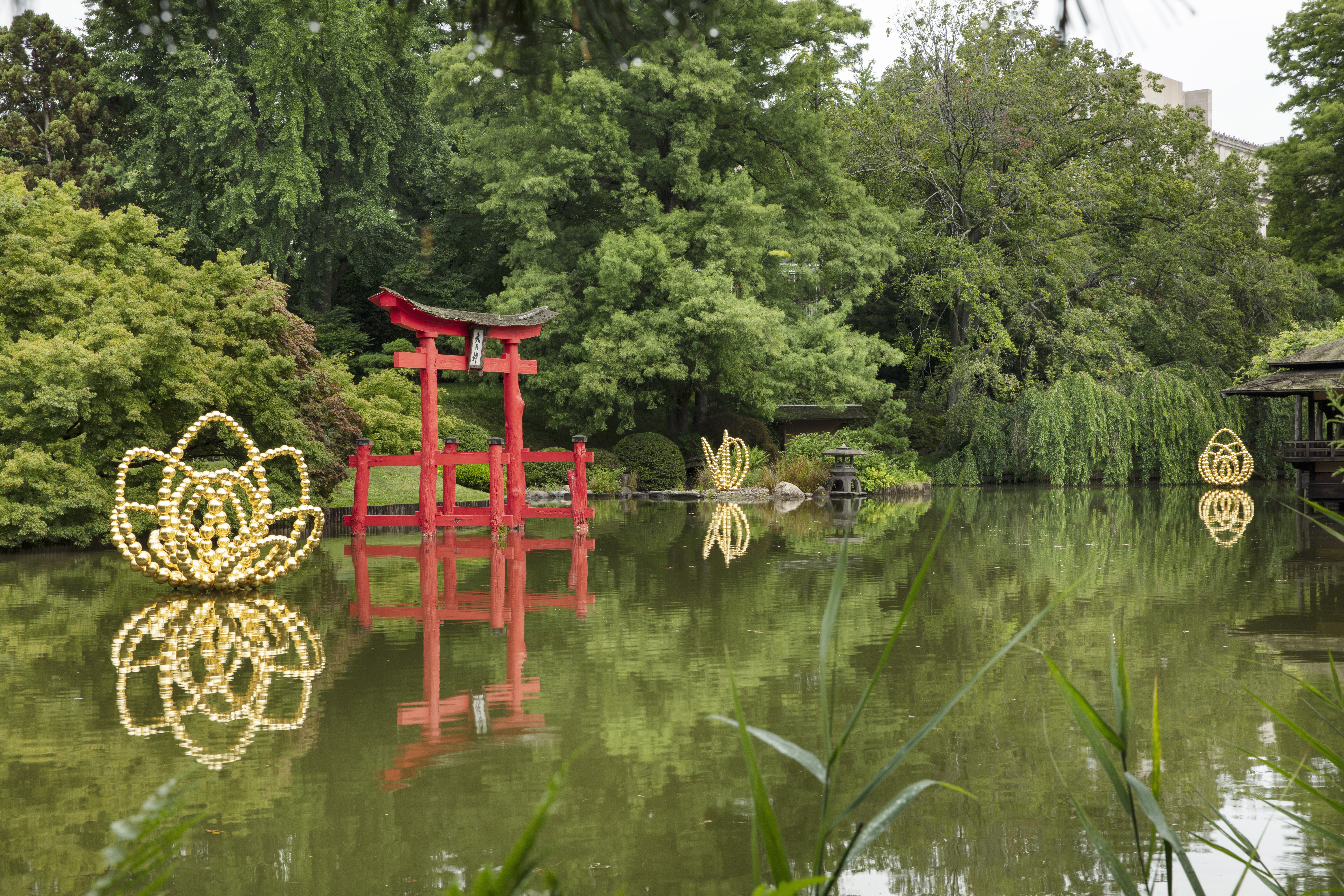
‘The Flowers of Hypnosis’ at the Japanese Hill-and-Pond Garden at Brooklyn Botanic Garden. Photographer: Guillaume Ziccarelli. ©Jean-Michel Othoniel / ADAGP, Paris & ARS, New York 2023. Courtesy of the artist and Perrotin.
That tranquil vantage point offers the soft song of water lapping at the suspended pavilion, flashes of koi fish in the pond and views of a vivid red gate that contrasts Othoniel’s sculptures beautifully.
The artist grew up with a grandmother who gardened for fun and for food. He started traveling while studying art — and made a point to see different gardens in different cities. It’s a sumptuous way to learn a civilization’s values, he said. Othoniel made his first visit to Japan 30 years ago — he elected to work with gold for this spot due to its significance in Japanese culture, exemplified by kintsugi, the art of repairing broken ceramics with the precious metal to highlight the “flaws.” He called Brooklyn Botanic Garden’s Japanese garden, the country’s oldest, “magical.” The Garden’s luck-bringing cherry blossoms, which bloom each spring, line pathways around it.
“Poetry is very important in my work,” Othoniel said. “The world is so hard and difficult for people. If we can, as artists, give a proposal of a poetic vision of the world, it will help us survive.”
While it’s tempting to stay and watch wildlife enjoy the pond all day, moving on has its own reward. As visitors walk by Othoniel’s two lotuses in the water, they appear to bloom and close in a tantalizing illusion. Experience it on your way to the Fragrance Garden. Created in 1955, it’s the only garden in America designed specifically for people with visual impairments, an eye-shaped ring of herbs and flowers that guests can touch to get the smell on their hands, with a grass island in its middle. Braille labels accompany the flora — as it does Othoniel’s rose-shaped sculpture, which honors that most fragrant flower. This September, he said, Dior will install perfume atomizers for visitors to sniff. The artist wants to make mini models of his sculpture for attendees to hold, too. He’ll likely be back in the city for his solo show opening at Perrotin on October 27. Fragrance, meanwhile, won’t translate over Instagram. It forces people to get out of the house.
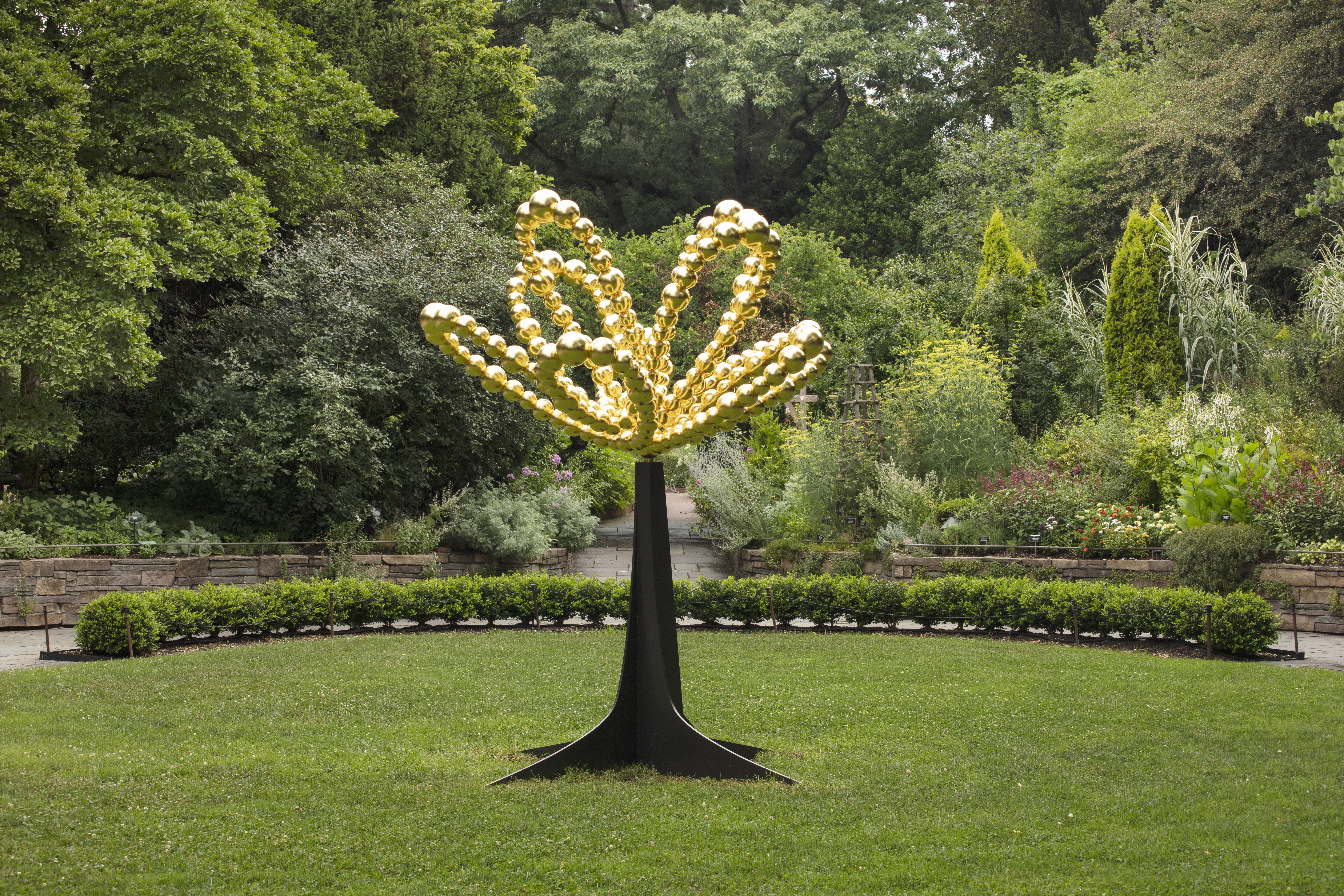

‘The Flowers of Hypnosis’ at the Fragrance Garden at Brooklyn Botanic Garden. Photographer: Guillaume Ziccarelli. ©Jean-Michel Othoniel / ADAGP, Paris & ARS, New York 2023. Courtesy of the artist and Perrotin.
The breathtaking Lily Pond Terrace nearby dramatically concludes “The Flowers of Hypnosis” with two more massive lotuses, this time crafted from mirrored stainless steel, one perched atop each pool. Both pools host dozens of varieties of lilies and lotuses, all labeled with their name, discovery date and place of origin — the Brooklyn Botanic Garden is a scientific body, as well.
As the sun emerges from the morning’s overcast skies, the reflection of these two sculptures on the water beneath them is particularly striking. At the same time, sunlight glinting off the water is reflected in both the sculptures in turn, set alight by the water’s shimmer, the nearby lily and lotus clusters, clothing on people passing by, even the sculptures themselves.
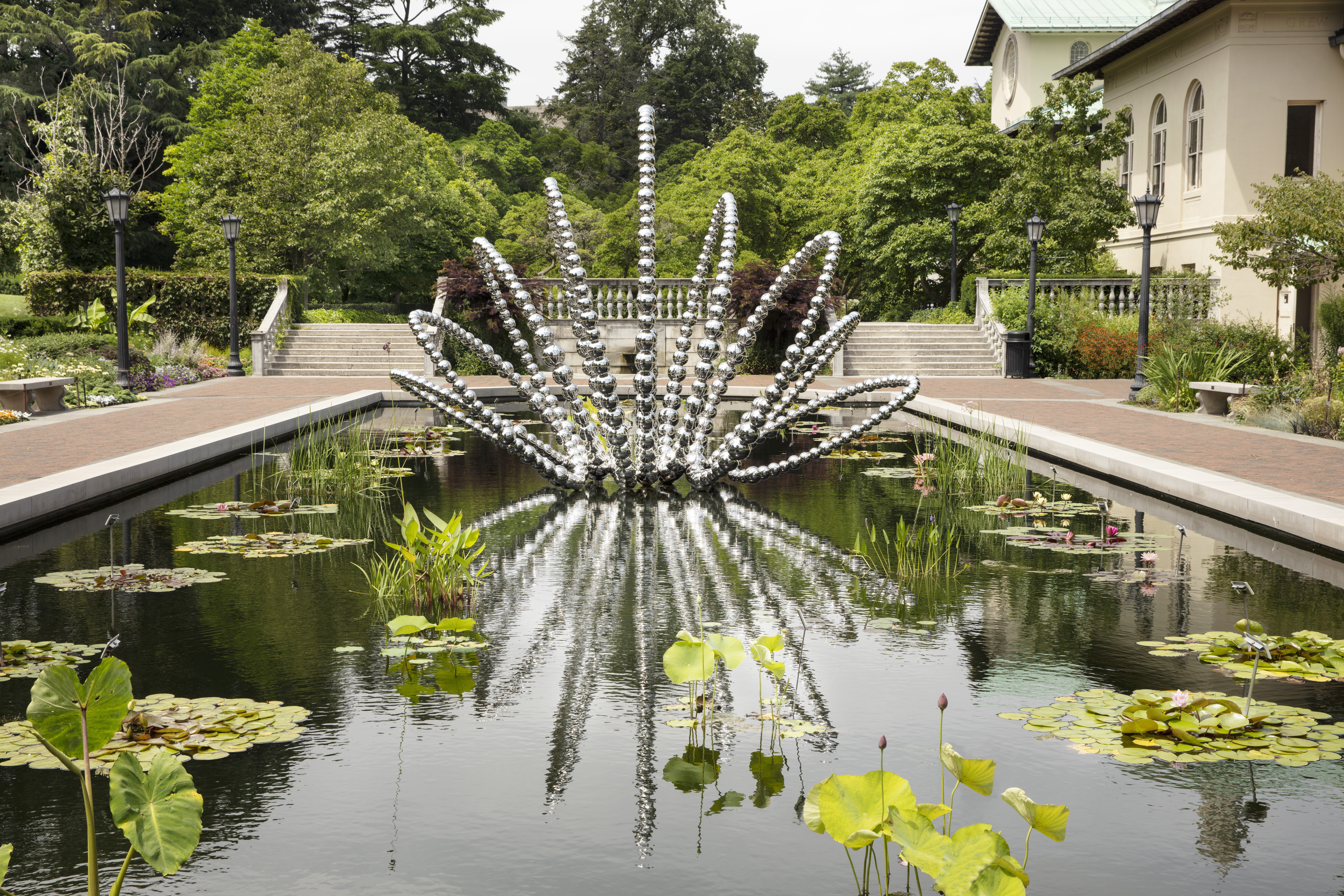

‘The Flowers of Hypnosis’ at the Lily Pond at Brooklyn Botanic Garden. Photographer: Guillaume Ziccarelli. ©Jean-Michel Othoniel / ADAGP, Paris & ARS, New York 2023. Courtesy of the artist and Perrotin.
“It’s like the DNA of the sculpture,” Othoniel says of the mesmerizing visual impact. “When you look at [the work], it’s very bright and seductive and beautiful. But beyond this beauty, there is also really your concern [for] the world.”
The lotus flower, which blossoms from the muck, symbolizes rebirth. Othoniel dreams of inspiring just one kid to become an artist with this show, by demonstrating how an artwork can envelop and reframe reality at once. Gardens are places for escape through the senses — for daydreaming, and discovering new possibilities.
“Beauty is important in our civilization, something we have to fight for,” he says. “It’s a political act to bring beauty into the world.”
You might also like 

















